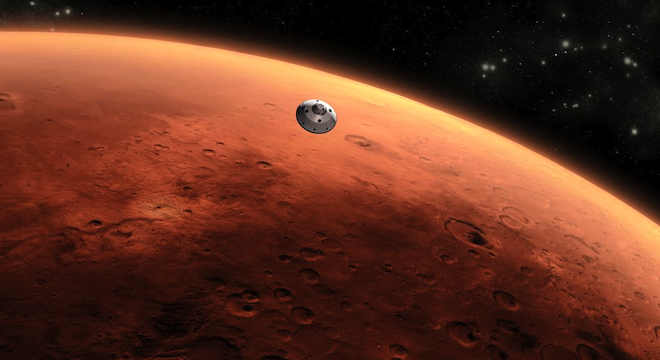As it turns out, Mars and Earth may be more similar than previously thought in one momentous way: Mars appears to have plate tectonics –giant pieces of the planet’s crust that move, break apart and smash into each other, forming such features as mountains, canyons and volcanoes — and experiences earthquakes, according to a new study of satellite data by a geologist at the University of California Los Angeles (UCLA).
Even more earth-shattering (or, more accurately, Mars-shattering) is UCLA geology professor An Yin‘s assertion that the existence of plate tectonics on the Red Planet increase the chances that it had conditions capable of supporting life at some point in its history.
“The operation of plate tectonics on Mars means that recycling of major chemical elements relevant to the existence of life such as water and carbon is much more dynamic, rapid, and interactive between deep mantle and Mars atmosphere,” said Yin, in an email to TPM. “This condition is much more favorable to the existence of life than the rather isolated systems on other planetary bodies such as Moon and Mercury.”
That being said, Yin’s new theory of plate tectonics on Mars, which is described in a new paper published in the August issue of the journal Lithosphere could have implications for the conditions of other planets in the solar system as well.
Specifically, the same triggering mechanism that caused plate tectonics to form on Earth and Mars may have also caused the crust of other planets to break apart into pieces as well.
“We know that large impacts occurred over a very short time window between about 4.1 and about 3.9 billion years in the history of the solar system evolution known as the ‘late heavy bombardment’,” Yin wrote, referring to a theorized period of the solar system’s history when the interactions of the orbits of Jupiter and Saturn caused an outer ring of countless comets and asteroids to disperse and crash into all the rest of the planets, including Earth and Mars, which were battered by the bodies. It was these impacts, especially of larger objects, that are thought to have caused the Earth’s crust to break apart into chunks.
The same bombardment should have had the same effect on other rocky planets, but despite years of exploration by interplanetary probes and telescopes, plate tectonics have only been observed on Earth, at least until now.
Yin has an explanation for why that’s the case.
“If the crust is too thick at the time of heavy impacts, the overall lithosphere will be too light to subduct,” or have one plate sink under another, as Yin wrote. “I suspect that was the case for Mercury and Venus, which explains why [they] lack plate tectonics.”
Previously, Mars wasn’t widely thought to have plate tectonics, either, as Yin explained.
“Professor Norm Sleep at Stanford University first proposed that plate tectonics might have occurred on Mars in 1992,” Yin acknowledged. However, the theory was “quickly abandoned,” according to Yin, due to the fact that the age of various features on Mars that should have been caused by plate tectonics were dated to around the same time period, when, if they acted as plate tectonics have on Earth, they should’ve formed over a longer period of time as the various plates moved around over eons.
However, Yin’s model addresses this discrepancy by proposing that Martian plate tectonics “occurred locally rather than globally on Mars as Sleep originally proposed,” — that is, in smaller, more contained regions.
Yin’s theory rests on his new reading of around 100 new images of the Martian surface captured by the Mars Reconnaissance Orbiter, a NASA satellite currently circling the Red Planet and helping to beam back transmissions from the recently-landed NASA Mars Curiosity Rover.
As for the potential of plate tectonics to affect the Mars Curiosity Rover’s mission — or even, in the worst case scenario, a quake to strike the region of the planet where the rover is active (the Eastern central part) — Yin was optimistic that things would remain calm.
“The Curiosity rover is landed far away from any of the active faults and I do not see any problem,” Yin told TPM.
Still, if a quake were to strike on Mars, it could be just as powerful as those experienced on Earth.
“I expect Mars quakes to be similar in size to those on Earth,” Yin wrote.






